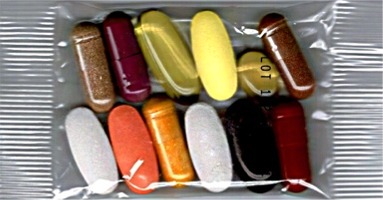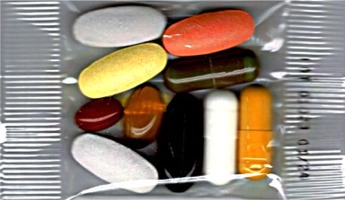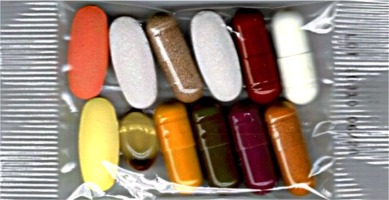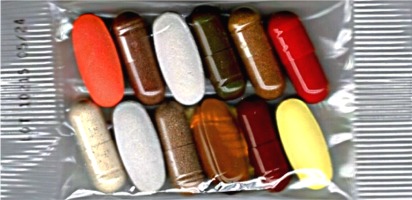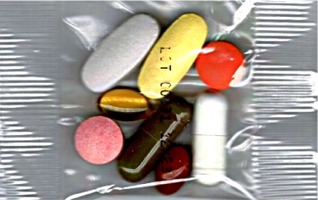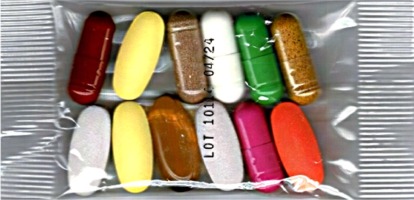When not at the Pentagon or on active duty in the Naval Reserves, Daniel W.
Nixon, M.D. serves as vice president of professional education for the
American Cancer Society in Atlanta. Prior to his current position, Dr. Nixon
spent the majority of his career in medical oncology at Emory University
School of Medicine, with more than 15 years of specialized research in
diet-related manuscripts in books and journals. He currently serves on several
nutrition committees for the National Cancer Institute and is co-editor in
chief of the internationally recognized journal, Cancer Prevention.
How do the new dietary guidelines recently issued by the American
Cancer Society differ from the previous version?
The American Cancer Society (ACS) first published nutritional guidelines in
1982, and they have evolved over time. Today, ACS guidelines are not
materially different from the dietary recommendations of the National Cancer
Institute and the American Heart Association. All three organizations stress
the importance of eating a low-fat, high-fiber diet and plenty of fruits and
vegetables.
The new ACS guidelines emphasize eating a variety of foods. It seemed that
some people were eating only cruciferous vegetables to the exclusion of other
foods. Thus, we stress the need to eat a varied diet, rather than any one
particular food or group of foods.
Our new guidelines also emphasize the need to limit or control obesity, not
only through decreased caloric intake, but through exercise as well. The
leading ACS recommendation is to avoid being overweight.
Why aren't there any quantitative recommendations in the new
guidelines?
We feel the data are not solid enough to quantify now many grams of fiber
it takes to prevent colon cancer, for example, or how few grams of fat will
reduce risk of breast cancer. We give a general range for dietary fat, which
is 30 percent of calories or less.
Is it the percent of calories from fat or the total number of
calories in the diet that increases cancer risk?
Fat intake and total calories are both important. It's clear from animal
studies that both fat itself and calories, whether from fat or from other
foods, play a role, probably not as cancer initiators but as cancer promoters.
What is the current evidence on polyunsaturated fat and cancer?
The polyunsaturate story is still very cloudy as far as cancer is
concerned. At this point, we would advise people to watch their total fat
intake rather than worry about the type of fat they're consuming.
Why does being overweight increase the risk of cancer?
There are two phenomena going on. When people consume excess calories, it
stimulates the metabolic overdrive into making cells divide faster. This
increases the risk that something can go awry, resulting in cancerous cells.
Then too, fat people have more cells, so there is an increased statistical
chance that some of those cells might become cancerous.
What role do antioxidants play in preventing cancer?
Vitamins A, C and E are known to have certain antioxidant properties. It's
believed that these antioxidants work by stopping damage to the DNA; or if the
DNA is already damaged, they help in its repair.
But there are also other properties in vitamins that work to prevent
cancer. For example, vitamin A retinoids seem to be able to take cells that
are on the way to becoming malignant and help restore them to normal activity.
This has been shown in studies of pre-malignant regions of the head and neck;
doses of synthetic retinoids have been able to reverse that condition. So
there's more than one possible good effect of vitamins.
ANR Formula One,
Two, Three, Four,
Five, Six, Seven
Heart, Alert, Maximus,
CATALOG
ACS Guidelines on Diet, Nutrition and Cancer
- Maintain a desirable body weight.
- Eat a varied diet.
- Include a variety of both vegetables and fruits in the daily diet.
- Eat more high-fiber foods, such as whole-grained cereals, legumes,
vegetables and fruits.
- Cut down on total fat intake.
- Limit consumption of alcoholic beverages, if you drink at all.
- Limit consumption of salt-cured, smoked and nitrite-preserved foods.
ANR Formula One,
Two, Three, Four,
Five, Six, Seven
Heart, Alert, Maximus,
CATALOG
Do so-called "designer foods" hold great potential in
cancer prevention?
We're just beginning to understand what characteristics to design into
foods. Foods, including fruits and vegetables, have many more useful
substances in them besides vitamins. In designing anti-cancer foods like the
'super carrot,' we don't want to inadvertently eliminate other essential
components at the same time. For example, there are potentially beneficial
chemicals in foods that are not nutrients as we understand them. The compound
beta-glycyrrhetinic acid gives licorice its distinctive taste, but is also a
potent chemo-preventive agent in laboratory animals. It's not a nutrient in
the standard sense.
That's also why ACS's nutritional guidelines don't include the
recommendation to take vitamin supplements. It's not just the benefits of
certain vitamins in food, but rather the combination of vitamins and these
compounds that can help reduce cancer risk.
Are people who consume more fruits and vegetables at increased
cancer risk from pesticide residues?
The consensus of our work study group on diet, nutrition and cancer was
that the benefits of eating fruits and vegetables far outweigh any potential
risk from pesticide residues.
Most pesticide residues are reduced through food processing and by washing
fruits and vegetables. Nonetheless, the committee will continue to monitor
data in this area.
Should parents be concerned about the pesticide risks to infants
and children?
The ACS dietary guidelines apply to children over the age of two years. But
in terms of nutritional guidelines for young children, I think parents should
be more concerned about the overall eating patterns they're setting for their
lifetimes, rather than focusing on any specific food risks like pesticide
residues.
What kinds of cancers affect children? Are they related to diet in
any way?
The common types of pediatric cancers are bone tumors, leukemias, brain
tumors and lymphpomas such as Hodgkin's lymphoma. But in the childhood group,
I'm not aware of any increase in tumors that are thought to be linked to diet.
That's why it's important that good eating habits are set for a lifetime,
because the diet-related tumors are those that affect adults - breast cancer,
colon cancer and prostate cancer, for example.
What about the natural carcinogens that are present in food?
One thing that has confused the public is the difference between a mutagen
and a carcinogen; they're not the same thing. Just because something is a
mutagen, which means it can change bacteria on the Ames test, does not mean it
will cause cancer in humans.
The fact that food mutagens are present is not proof that food carcinogens
are present. Nonetheless, the liver has developed a sophisticated
detoxification system to ward off these compounds fairly efficiently.
What kinds of dietary research is ACS currently funding?
We've just completed field-testing the new ACS dietary guidelines with a
healthy population to determine if they accomplished what we intended (see
above). With the success of that project, we're now moving into the next phase
of our research plan, which aims to develop cancer- specific nutritional
guidelines.
We're funding two studies: one limits dietary fat intake in patients with
breast cancer and the other prescribes a high-fiber cereal for persons with
abnormal polyps of the colon.
ANR Formula One,
Two, Three, Four,
Five, Six, Seven
Heart, Alert, Maximus,
CATALOG
Keeping in Shape
How likely are you to lose weight on a Mediterranean cruise? Not very,
unless the only meals available are prepared according to the new American
Cancer Society dietary guidelines. To put those guidelines to the test, ACS
tried them out on an entire U.S. Navy crew that was shipped to the
Mediterranean for a six-month deployment in 1990. Before they went to sea, the
ship's cooks were instructed on how to prepare menus designed to conform to
the new guidelines and crew members were educated about them as well as the
importance of exercise.
Before and after the mission, the 350 crew members on the USS Scott
underwent tests to determine their overall health. For comparison, similar
data were collected from crew members on a separate ship on which standard
Navy menus were served. Preliminary results showed immediate health benefits
for the USS Scott crew.
USS Scott crew members lost an average of 10 pounds and took nearly two
inches off their waists. Crew members on the other ship gained an average of
seven pounds and their waist sizes grew one to two inches.
In addition, of those USS Scott members who weighed 200 pounds or more at
the start of the mission, 74 percent lost weight. Only 26 percent of the
similar group lost weight on the other ship, and 74 percent of the 200
pound-plus group gained weight.
For meals, sailors were served foods like oven-roasted lean meats and baked
potatoes in place of fried steaks and mashed potatoes with gravy. Low-fat
frozen yogurt and low-fat cookies were offered in place of other higher-fat
desserts.
The USS Scott commander was concerned that a change of diet not adversely
affect the crew's morale, so he insisted that the ship's commissary continue
to sell candies and other snacks. It appears those occasional foods did not
interfere with the overall benefits of the ACS diet.
As it turns out, many sailors on the USS Scott preferred the new diet and
44 percent said they would maintain similar eating habits on land.
Reprinted from the International Food Information Council Foundation, 1992
Also see:
Phytochemicals: Nutrients Of
The Future
Antioxidants: An Antidote to
Aging?
Better Eating for Better Aging
Nutrition Is Key To Successful
Aging: Kidd
Latest Concepts in Nutrition
Life Long Weight Management
for Health & Happiness
10 Tips to Healthy Eating
New Perspectives on Diet and
Cancer
Upbeat on Fiber for Longer
Life & Better Health
A Refresher On Water for Long
Life & Health
Reference Guide for Vitamins
Reference Guide for Minerals
Reference Guide for Herbs
Reference Guide for Amino
Acids
Reference Guide for Special
Nutrients
Reference Guide for
Anti-Oxidants
Reference Guide for Nutritional
Greens
Reference Guide for Digestive
Nutrients
Reference Guide for Dietary
Fibers
Suggested Readings and Guide
References
ANR Formula One,
Two, Three, Four,
Five, Six, Seven
Heart, Alert, Maximus,
CATALOG
|
